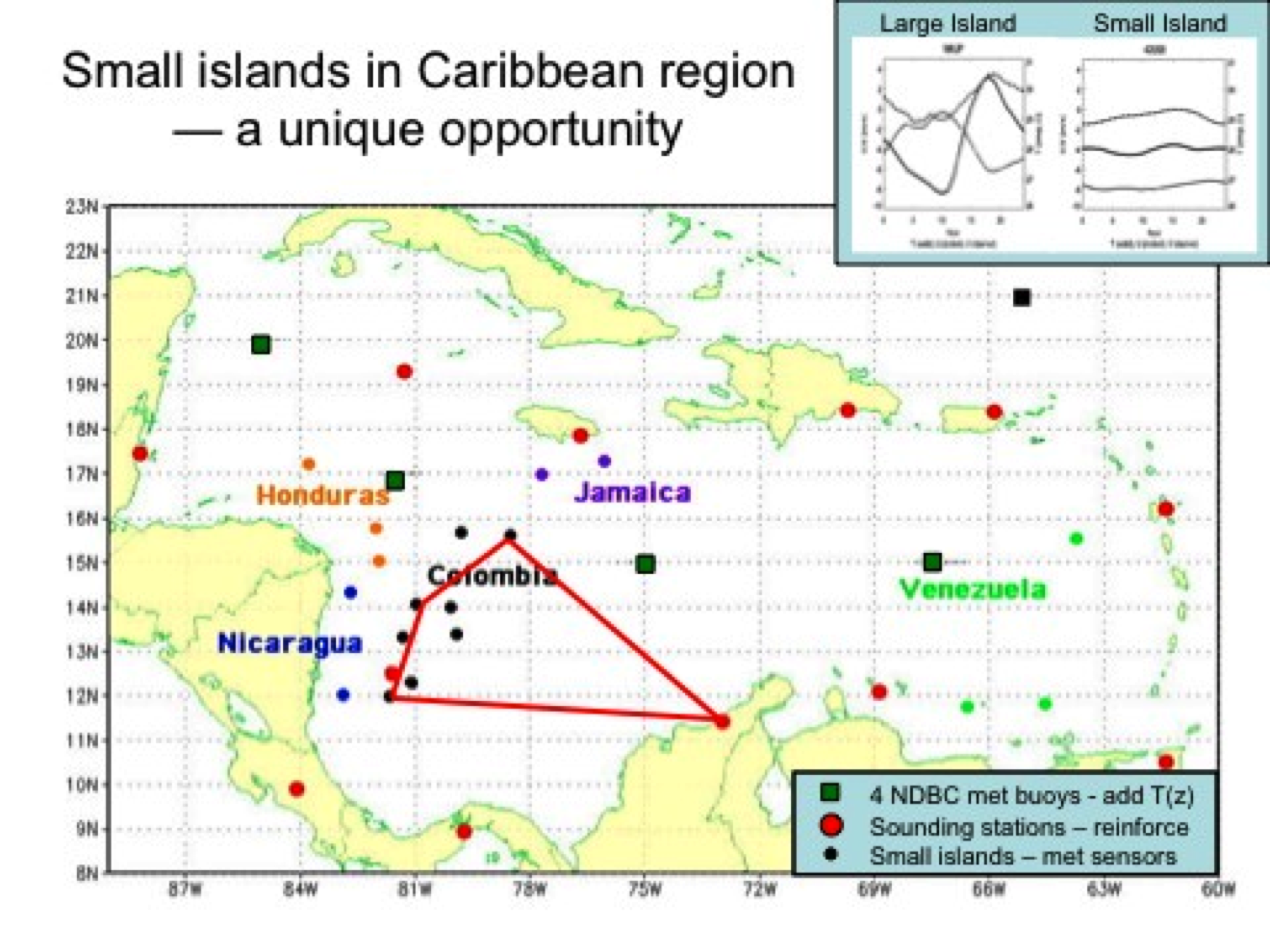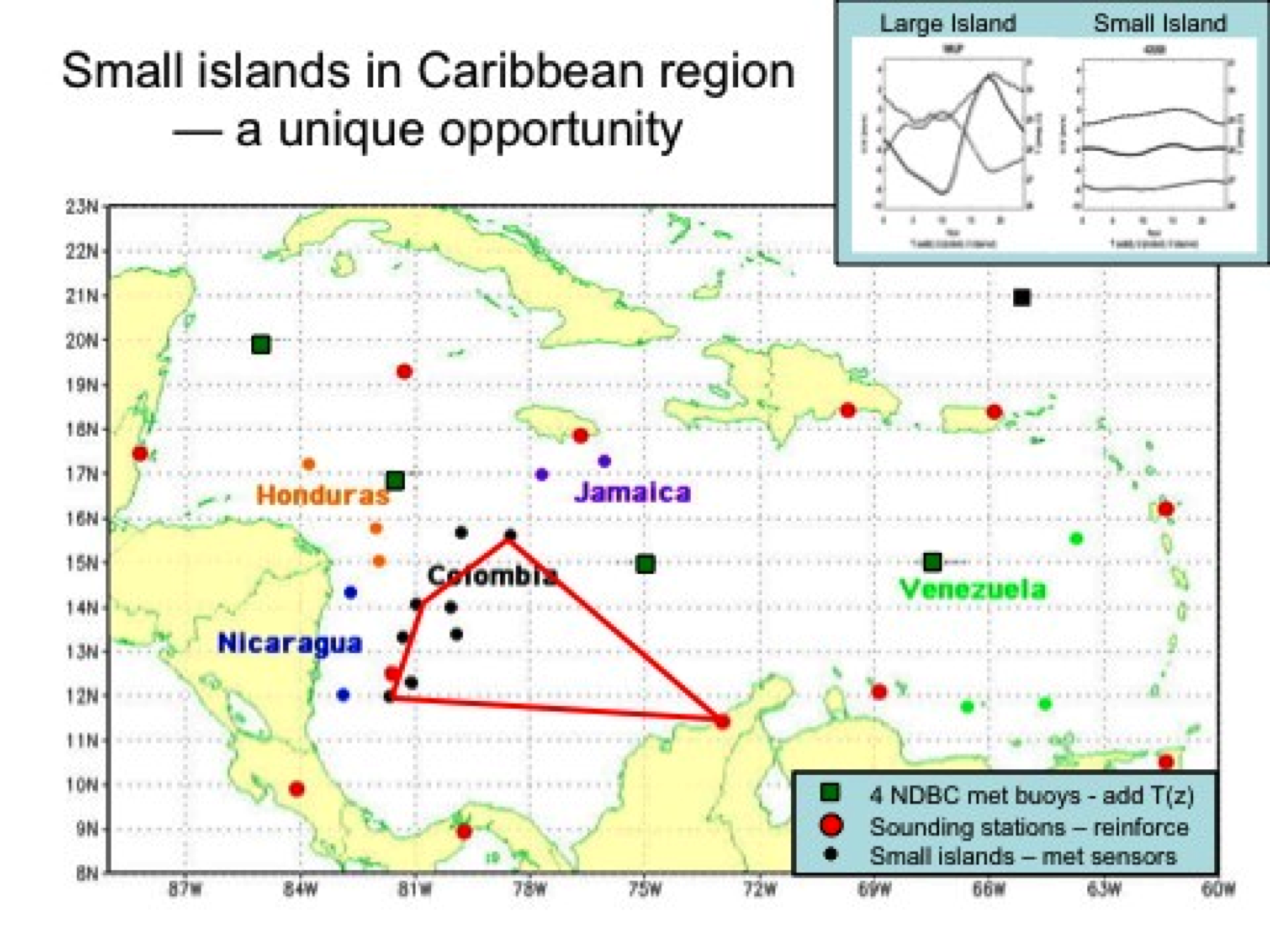IASCLIP trip #1 June 22-30
Colombia and the Dominican Republic
Participants: Art Douglas, Dave Enfield, Michael Douglas
The purpose of this trip was to contact the various institutions in Colombia that can potentially benefit from working with IASCLIP and which can help IASCLIP do a better job through the establishment of a useful cooperative framework. Spent 2 days each in Bogota (weather & climate service, IDEAM; air force; and naval central command, DIMAR), Medellin (national university) and Cartagena (navy hydrographic service, CIOH). At each venue we typically gave presentations to inform our hosts on the nature of IASCLIP, problems needing to be solved, especially in the realm of observations, and potential ideas for cooperation.
Bogota: At IDEAM, the situation with the radiosonde on San Andres Island was mentioned; they are still having problems with the hydrogen generator but expect to restart very soon now that the old generator is being used as a backup. This station has not been operational for over a year.
IDEAM is sending data to NCEP from about 27 synoptic stations but only a fraction of these are getting in to NCEP or NCDC. They mentioned data transmission problems. Art will be checking on this.
All of the IDEAM surface data is digitized. By law the data cannot be made available for free but subsets of the data can be made available, possibly free of charge, to researchers if the proper requests are received.
IDEAM has about 2800 climatological stations and 27 synoptic stations. They will soon start quality control of the surface data.
The Air Force has a small meteorology department with 15 people and produces their own forecasts. Recently in collaboration with IDEAM they have installed a new radiosonde station in Tres Esquinas. They have personnel in different areas of the country that could participate in joint activities in the future.
The National University of Colombia in Bogota has a Master degree program in Atmospheric Sciences. They mentioned that they may not be able to help in making observations but they are willing to collaborate in the research aspects of any IASCLIP in the future. They expressed interest in having a researcher’s exchange by having some of their researchers visit institutions in the US and vice-versa.
At DIMAR (Navy) we discussed mainly the possibility of using some of the key islands owned by Colombia to set up instrumentation. Although the personnel operating in these islands is rotated monthly, they thought that there are ways to maintain continuity of the knowledge needed to maintain/operate any equipment that may be set up.
The key concern was the need for a more formal arrangement, ideally an agreement of technical cooperation between them and the US should be in place before any deployment of researchers or equipment to the islands. The Colombian Navy has 8 coastal buoys operating. They have also been in talks with Jamaica to see if they can install some equipment on Jamaican islands. Recently a station has been installed at Malpelo by IDEAM but with their help.
In Medellin: We met with professors from the National University. They are primarily involved in hydrometeorology research but they are interested in possible collaboration with IASCLIP researchers. They have a graduate program and plenty of students that may contribute in possible research projects.
In Cartagena: In Cartagena we had two meetings at the CIOH (Center for Oceanographic and Hydrographic Research), a branch of the Colombian Navy. They are part of the Navy and are directly responsible for the islands and coastal areas in the Atlantic (see figure below). They mentioned that rotation of personnel which is done monthly could be a problem for maintaining trained personnel on a regular basis. However some solutions were also discussed.
They appeared interested in possible collaboration with IASCLIP researchers. They do some research themselves as well as their own forecasts. During second meeting a draft was prepared of a letter of intent that may be circulated soon to try to get permission for a US researcher or two to participate in one of their routine cruises to Malpelo and other islands. This would be done to ascertain the local conditions and possibilities at each place for installation of meteorological equipment. Such a letter would have to be signed by their director and by someone in NOAA.
While in Cartagena we spoke to Cesar Toro, director of IOCARIBE. He gave an overview of the different groups and possible contacts in the area of interests.
 |
|
Colombian islands (black dots) where met observations can be made and oceanic observations taken on monthly logistical cruises by the Colombian navy. |
Data Submission Instructions
Data Set Documentation Guidelines
IASCLiP Implementation Strategy
IASCLiP Logos
Caribbean Outlook Forum 2010
Trip Report: Colombia
Trip Report: Dominican Republic
Trip Report: Central America
Warm Pool Monitoring at NOAA/AOML
Institutions, Offices, and Organizations
